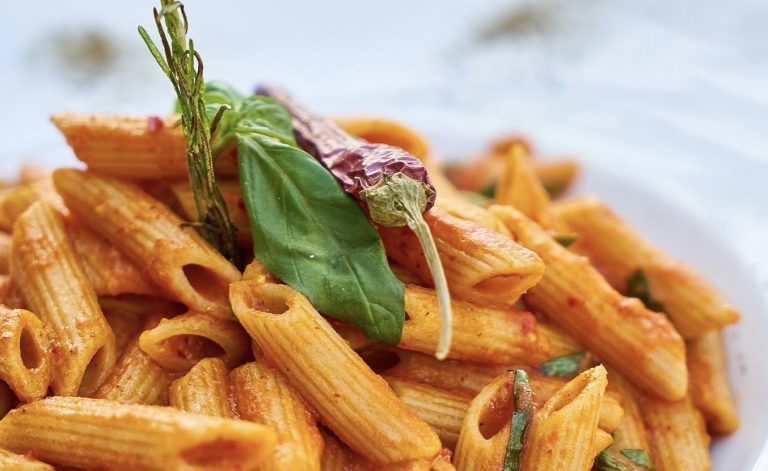Pasta. We all love it. In fact, Italian food has been touted as the most popular cuisine globally. And while it’s so good it’s hard to believe you can get it wrong, Italians the world over are looking down on certain myths that have developed around how it’s cooked. So, what are these big no-nos and how should you correct them? We’ve got the authentic answers.
1. Throw the pasta against the wall
There’s no bigger myth than this. In fact, if you tell an Italian person that you throw pasta against the wall to make sure it’s cooked, you might give them an aneurysm (or risk an extremely shocked and furious reaction, like this TikTok that reached 4 million likes). The concept is as simple as it is traumatising — in order to know whether your spaghetti is ready, you should pelt it against the nearest wall. If it sticks, it’s ready. Otherwise, you should give it a couple more minutes and try again.
The truth is, this is wrong for many reasons. Firstly, it’s just messy. Secondly, it’s a waste of precious noodles. But most importantly, if the pasta sticks, it means it’s already overdone. In order to understand faultless pasta cooking, we have to understand the concept of al dente, which is “the ideal consistency of pasta when it’s been cooked,” according to the experts at Pasta Evangelists. “The literal translation of the phrase is ‘to the tooth’ because pasta that is perfectly al dente will be quite firm to bite, not completely soft and limp” — in other words, the opposite of sticky. They recommend cooking the pasta for a little less than what’s stated on the packaging and tasting it, which makes far more sense.
2. Ignore the quality of the pasta
Just buy that supermarket own brand pack of penne and forget about it, no need to spend an extra few quid, right? Wrong. The grade of pasta is incredibly significant in assuring a mouthwatering bite, and getting poor quality noodles will impact your dish and make every Italian in your life roll their eyes in judgement. The reason is closely connected to the notion of al dente we’ve previously discussed — the texture of good quality pasta is just superior, and allows for the perfect al dente toothsomeness which the cheaper options can’t quite achieve.
What’s more, pasta never comes on its own — the sauce is essential for a great dish. To ensure the sauce marries the pasta properly, it needs to have a certain texture which is impossible to achieve with low quality packs. This is due to the fact that, to save time, mass manufacturers cut corners and dry the pasta too quickly and use teflon dies instead of brass and bronze, which destroys the texture. If you want to try a premium brand but aren’t sure where to start, this list is useful.
3. Put oil in the pasta water
“In order for pasta not to stick, you should add oil to the pasta water.” This is as common a sentiment as it is wrong. Not only is it a waste of valuable olive oil, but it won’t do what you expect it to. Instead of preventing your pasta from sticking together, it will make it slippery — essentially hindering its ability to fully be incorporated into the sauce.
If you don’t want your pasta to stick together, the solution is pretty straightforward: cook it slightly less than instructed, and mix it together with the sauce allowing it to cook further in it until perfectly al dente. If your pasta still sticks, you’ve either overdone it or purchased bad quality pasta which tends to be stickier.
4. Wash the pasta after cooking
Another faux pas to do with preventing your pasta from sticking together is draining it and then running it under cold water. When pasta cooks, starch is released into the water. This allows the sauce you will later serve your dish with to cling onto the noodles, giving it a creamy texture. By rinsing the pasta, you’re washing away the starch and dooming your bowl to a divorce of flavours. The starch also helps thicken the sauce, which is important especially with cheesy options.
The only exception to this rule is if you want to serve pasta cold (for example, in a salad), where you don’t need the starch to bind to the sauce. Otherwise, leave your pasta alone and even retain some of the cooking water for extra Italian points.
5. Add no salt to the pasta water
We’ve saved the best for last. Not salting your cooking water is at the very least sacrilegious to the average Italian. When it comes to a good pasta dish, it would be wrong to dismiss the pasta itself in favour of the sauce. Good, delicious noodles are a focal point, and unsalted water creates bland and frankly sad results that don’t taste quite right when it comes to the final result. No, adding it post-cooking will just not do — cooking the pasta in salty water ensures it is evenly seasoned inside and out, completely changing the game.
If you’re wondering just how much salt you should add to your pot, the answer is pretty much as much as you can. An old Italian saying claims that pasta water should be as salty as the Mediterranean Sea, but if you want an equation to help you, it’s usually recommended to use one litre of water with 10g of salt for every 100g of pasta. You’re welcome.


0 Comments